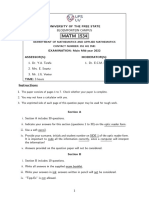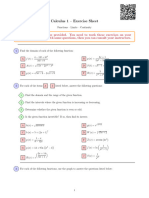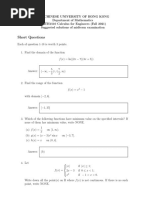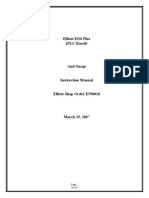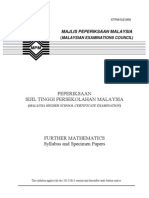Maths Assignment Unit 2
Uploaded by
Madhu MitaMaths Assignment Unit 2
Uploaded by
Madhu MitaMEENAKSIUSUNOARAJANENGINEERING COLLEGE,
EAR To All he Branches)
QUESTION BANK 1)
Subject Code Subject Name: MA3151[Matriccsand Calculus
Year / Scm : 1/1
UNIT U:DIFFV.RENTIAI.CALCULUS
Representatton of tunctions — Ltn)it of a function — Continuity — Derivatives — Differentiation ruJcs
(sum. product. quotient, chain rules) —hnplicit differentiation —Logarithmic d'tTerenttatton Applications
Masuna and Mtnttna of titnctlons of onc sariable.
Cl 10.2 A I ' differential calculus tools in various a lication roblems
PART A
Q. COM PE
QUESTIONS TENCE
co
No
1. BTU -3 Applying 10.2 POI,P02.
Evaluate lim POB
Find the derivative of the function f (x) = I + tan x BTU -3 Applying C110.2 POI.P02,
POB
3. BTU -3 Applying Cl 10.2 PO .P02,
POJ
BTL -3 Applying 10.2 POI.P02.
Check whether lim exist. P03
x +31
5. Find the critical points of y = 5x 3 —6x BTL -3 Applying C110.2
POJ
6. I + cos 2x BTU -3 Applying C110.2 POI,P02,
Evaluate 1m P03
(n —2.v) 2
7. BTU -3 Applying Cl 10.2 POl,P02,
Find — sin
dx P03
s. BTU -3 Applying C110.2 POl.P02,
Show that 1m x 2 sm — P03
x
9. Sketch the graph of the function B TL -3 Applying CHO. 2 POl,P02,
I + x,x<—l P03
.fl(.v)— x2, —l S x S I and use it to determinethe
values of ä"forwhich lim f (x) exists.
10. Does the curve v = -v —2.v2 +2 have any horizontal BTU -3 Applying C110.2 PO I ,P02,
tangents? If so where? P03
ll. Find — , if x = a cos O , y = asln
BTL -3 Applying C110.2 POI.P02,
d.v P03
12. if BTL -3 Applying C110.2 POI,P02,
Find log x
dx 1>03
13. find the derivative of sinx BTU -3 10.2 POI,P02,
P03
14. dy BTU -3 Applying C110.2 POI,P02,
Find— if Y = esin(iogv) 1303
dx
15. BTL -3 Applying CT 10.2 PO I ,P02,
Find— , if x P03
dx
PART-B
Q. COMPE POI ,P02,
No LEVEL TENCE P03
1. Find the values of 'a' and 'b' such that the function BTU -3 Applying 10.2 POI,P02,
X+2Ä<2 P03
.v < 3 is continuous
; x 23
everywhere.
Find the values of 'a' and 'b' such that the function BTL -3 Applying C110.2 POI,P02,
P03
a-v- —b.v43 ;2 C x < 3 is continuous
2x—a+b ;x 23
everywhere.
3. Guess the value of the limit (If it exists) for the function BTL -3 Applying ClJ0.2 POI ,P02,
P03
by evaluating the function at the given
numbers x = ±0.5, ± 0.01, ± 0.001,± 0.0001(correctto
six decimal places).
4. BTU -3 Applying 10.2 POI,P02,
Find the derivative of the function f(x) = — using the P03
definition of derivative. State the domain of the
function and the domain of its derivative.
5. Find the maximum and minimum values of the function BTU -3 Applying C 110.2 POl,P02,
P03
2
X
6 For the function / (x) = 2+2.1 .2 —x *findthe interval BTU -3 Applymg Cl 10.2 POI,P02,
of increase or decrease , local maximum and minimum
POB
values, the intervals of concavity and the inflection
points.
7. b + a cosx BTU -3 Applying C 110.2 PO I ,P02,
Find the derivative of .L(x) cos POB
u + b cos .v
8. Find y' for cos(.vy) = I + sin y BTU -3 Applying Cl 10.2 POI ,P02,
POB
9. For what value of the constant 'b' is the function f BTU -3 Applying C110.2 POI ,P02,
PC)3
continuouson (—T,Ø) /'(.v) =
—bx, 22
If the function ./(x) = 2-v•+ 3x 2 —36-r BTL -3 Applying 010.2 POI ,P02,
,find the
interval on which it is increase or decrease *the local P03
maximum and minimum values of f(x).
Find y" if x 4 + y 4 = 16. BTU -3 Applying C110.2 PO ,P02,
P03
Find the tangent line to the equation x + y = BTL -3 Applying POI,P02,
6xy at C110.2
the point (3,3) and at what point the tangent line P03
horizontal in the first quadrant.
13. Find the local maximum and minimum values of
BTL -3 Applying C110.2 POI,P02,
n (x) = — using both first and second derivative P03
test.
14. Find the
domain at which the function f (x) = 1M BTL -3 Applying C110.2 PO1802,
continuous and differentiable. P03
15. dy
Find — if y = x •e 2' (x 2 BTL -3 Applying C110.2 POI,P02,
dx
16. dv
Find — ,if sin x COS= cos vS•n.v BTL -3 Applymg C110.2 POI ,P02,
dx P03
17.
when y = stn x + BTL -3 Applying C110.2 POI,P02,
sin x + .....
P03
18.
dv BTL - 3 Applying C110.2 POI,P02.
Find — , if y =
dv P03
19. Find the absolute maximum and absolute minimum Applymg
BTU -3 C110.2 POI ,P02,
values of f (x) = 2x 3 —3x2 —12.v+l on the interval [- P03
2,3]
You might also like
- University of Mindanao Mechanical Engineering Correlation Courses (ME 500) Differential Calculus 01No ratings yetUniversity of Mindanao Mechanical Engineering Correlation Courses (ME 500) Differential Calculus 011 page
- Class 11 Maths Notes Chapter 13 Studyguide360No ratings yetClass 11 Maths Notes Chapter 13 Studyguide36013 pages
- (MATH1013) (2014) (F) Final cd827 96813No ratings yet(MATH1013) (2014) (F) Final cd827 9681311 pages
- IB Math HL Differentiation Past Exam Question69% (13)IB Math HL Differentiation Past Exam Question14 pages
- Kolossa MAT 266 Online B Spring 2024.cterzi - Review Calculus INo ratings yetKolossa MAT 266 Online B Spring 2024.cterzi - Review Calculus I10 pages
- The Copperbelt University School of Mathematics and Natural Sciences Department of MathematicsNo ratings yetThe Copperbelt University School of Mathematics and Natural Sciences Department of Mathematics12 pages
- MA2002 AY2023 2024 Sem 1 Midterm Test r1 SolNo ratings yetMA2002 AY2023 2024 Sem 1 Midterm Test r1 Sol7 pages
- Limits,_Continuity_and_Derivability_Eng[1]No ratings yetLimits,_Continuity_and_Derivability_Eng[1]27 pages
- Instructions:: Math 120, Common Final ExamNo ratings yetInstructions:: Math 120, Common Final Exam6 pages
- Exp. No: 1D Date: Application of Problem Solving Techniques - Electric Current in A Three PhaseNo ratings yetExp. No: 1D Date: Application of Problem Solving Techniques - Electric Current in A Three Phase4 pages
- A Vertex Chain Code Approach For Image Recognition: ICGST-GVIP Journal, Volume 5, Issue3, March 2005No ratings yetA Vertex Chain Code Approach For Image Recognition: ICGST-GVIP Journal, Volume 5, Issue3, March 20058 pages
- Differentiation All Pratic Sit WWW - EuelibraryNo ratings yetDifferentiation All Pratic Sit WWW - Euelibrary11 pages
- B.A. Programme Semester I 2019 With DSC The Individual and SocietyNo ratings yetB.A. Programme Semester I 2019 With DSC The Individual and Society59 pages
- LAB # 05 Tasks: Department of Computing Indus University, KarachiNo ratings yetLAB # 05 Tasks: Department of Computing Indus University, Karachi1 page
- Chapter One: 1.1 Optimal Control ProblemNo ratings yetChapter One: 1.1 Optimal Control Problem25 pages
- PEAK SEARCHING ALGORITHMS and APPLICATIONo ratings yetPEAK SEARCHING ALGORITHMS and APPLICATIO8 pages
- (Case Study at Mampong-Akuapem Presby Senior High School) : Staff Assignment ProblemNo ratings yet(Case Study at Mampong-Akuapem Presby Senior High School) : Staff Assignment Problem3 pages
- The Assignment Problem: Examwise Marks Disrtibution-AssignmentNo ratings yetThe Assignment Problem: Examwise Marks Disrtibution-Assignment59 pages
- Chapter Three: Applications of The DerivativeNo ratings yetChapter Three: Applications of The Derivative60 pages
- 24 06 2021 SR Super60 All Jee Main GTM 31 Question Paper0% (1)24 06 2021 SR Super60 All Jee Main GTM 31 Question Paper20 pages
